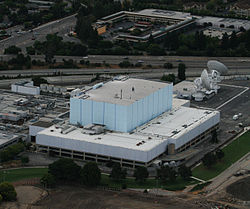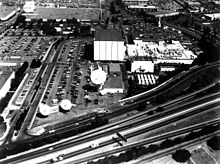
Vandenberg Space Force Base, previously Vandenberg Air Force Base, is a United States Space Force Base in Santa Barbara County, California. Established in 1941, Vandenberg Space Force Base is a space launch base, launching spacecraft from the Western Range, and also performs missile testing. The United States Space Force's Space Launch Delta 30 serves as the host delta for the base. In addition to its military space launch mission, Vandenberg Space Force Base also hosts space launches for civil and commercial space entities, such as NASA and SpaceX.

Moffett Federal Airfield, also known as Moffett Field, is a joint civil-military airport located in an unincorporated part of Santa Clara County, California, United States, between northern Mountain View and northern Sunnyvale. On November 10, 2014, NASA announced that it would be leasing 1,000 acres (400 ha) of the airfield property to Google for 60 years.
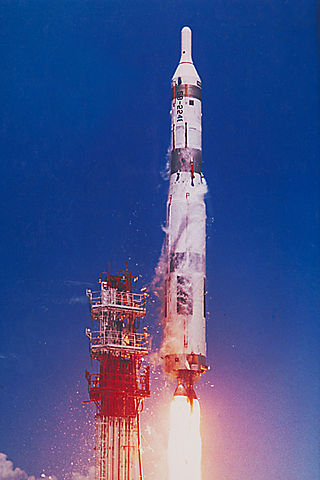
The Martin Marietta SM-68A/HGM-25A Titan I was the United States' first multistage intercontinental ballistic missile (ICBM), in use from 1959 until 1962. Though the SM-68A was operational for only three years, it spawned numerous follow-on models that were a part of the U.S. arsenal and space launch capability. The Titan I was unique among the Titan models in that it used liquid oxygen and RP-1 as propellants; all subsequent versions used storable propellants instead.
The Satellite Control Network (SCN), operated by the United States Space Force's Space Delta 6, provides support for the operation, control, and maintenance of a variety of United States Department of Defense and some non-DoD satellites. This involves continual execution of Telemetry, Tracking, and Commanding (TT&C) operations. In addition, the SCN provides prelaunch checkout and simulation, launch support, and early orbit support while satellites are in initial or transfer orbits and require maneuvering to their final orbit. The SCN provides tracking data to help maintain the catalog of space objects and distributes various data such as satellite ephemeris, almanacs, and other information. It was previously known as the Air Force Satellite Control Network (AFSCN) while under Air Force Space Command's 50th Network Operations Group.
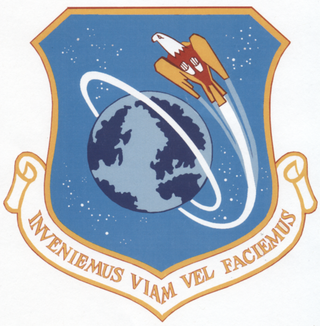
The United States Air Force's Air Force Satellite Control Facility (AFSCF) was a space command and control unit located at Onizuka AFS, California. It has the distinction of being heavily involved in the world's first reconnaissance satellite program, CORONA. Due to geological hazards, and the terrorism threat from its proximity to a major transportation link, the facility's command and control functions were moved to Schriever AFB, Colorado.

New Boston Space Force Station (BOSS) is a United States Space Force facility located in Hillsborough County in south central New Hampshire. It was transferred from the United States Air Force to the Space Force in the summer of 2020.

The 50th Wing is an inactive United States Air Force wing.

The 21st Space Operations Squadron is a satellite control unit of the Space Delta 6 of the United States Space Force, located at Vandenberg Space Force Base, California. Prior to July 2020, it was part of the 50th Network Operations Group. It operated Onizuka Air Force Station from its formation in 1991 until the closure of the station in 2010.

The 3rd Space Operations Squadron is a United States Space Force unit responsible for conducting on-orbit operations. It is located at Schriever Space Force Base, Colorado.

The 5th Expeditionary Space Operations Squadron is an expeditionary satellite operations unit of the United States Air Force, assigned to the Air Force Space Command for activation or inactivation as required.

The United States Air Force's 750th Space Group was a space operations unit located at Onizuka Air Force Station, California. its predecessor was formed on 1 October 1987; it assumed the designation of the 750th Space Group on 30 January 1992; and it was inactivated on 25 June 1999.

Space Systems Command (SSC) is the United States Space Force's space development, acquisition, launch, and logistics field command. It is headquartered at Los Angeles Air Force Base, California, and manages the United States' space launch ranges.

The 10th Aerospace Defense Group was inactivated on 31 December 1970 by the United States Air Force (USAF). Its last assignment was with Fourteenth Aerospace Force at Vandenberg Air Force Base, California. The 10th Aerospace Defense Group and Squadron were the sole operators of the United States' second nuclear-tipped anti-satellite weapon, Weapons System 437 (WS-437). For this reason the squadron continues the group history through temporary bestowal.
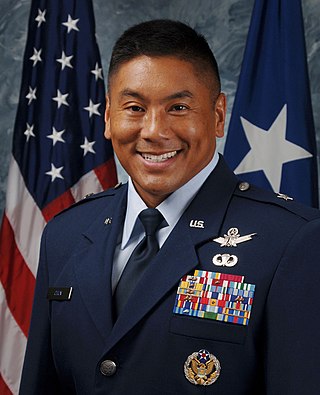
Brigadier General Cary C. Chun is a retired senior officer of the United States Air Force. He served as the Deputy Commander, Operations and Interagency Integration, Joint Functional Component Command for Space, United States Strategic Command (USSTRATCOM), and the Director for Mission Operations, National Reconnaissance Office. In this role, he led all Department of Defense space forces aligned with USSTRATCOM and provided tailored, responsive, local and global effects in support of national, USSTRATCOM and combatant commander objectives. As Director for Mission Operations, he led operations for all NRO overhead reconnaissance systems, ground stations, operational communications, and the operations center used to conduct intelligence activities essential for the national security of the United States and its allies.

Morse Field is a former military airfield located approximately 12 miles (19 km) south-southwest of Naʻālehu, Hawaii. It was also known as South Cape Airport, South Point Air Force Station, or Ka Lae Military Reservation. It is now abandoned.

Sandra E. Finan was the Deputy Chief Information Officer for Command, Control, Communications and Computers (C4) and Information Infrastructure Capabilities, Office of the Secretary of Defense, Pentagon, Washington D.C.
A Space Operations Center (SOC) is a facility such as a Mission Control Center for controlling spaceflight and/or spacelift missions, and may refer to:

Space Operations Command (SpOC) is the United States Space Force's space operations, cyber operations, and intelligence field command. Headquartered at Peterson Space Force Base, Colorado, it consists of its mission deltas, and garrison commands.

Christopher Stephen Povak is a United States Space Force major general who serves as the deputy director of the National Reconnaissance Office and commander of the Space Force Element to the National Reconnaissance Office. He previously served as the deputy director of the Space Warfighting Analysis Center.

Space Delta 12 is a United States Space Force unit responsible for space test and evaluation. It tests space systems and capabilities in support of weapon system acquisition, operational acceptance, and readiness. It was established on 23 August 2021 following the establishment of the Space Training and Readiness Command, the field command to which it reports. It is temporarily headquartered at Schriever Space Force Base, Colorado, but its final location requires a base selection process.
